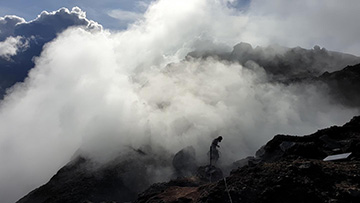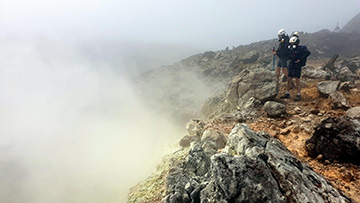A researcher lays fiber optic cable close to the fumarole at the summit of La Soufrière de Guadeloupe. [Image: Romain Feron] [Enlarge image]
Atop the Caribbean’s fiery La Soufrière de Guadeloupe Volcano, researchers report an optical seismometer able to track critical seismic activity near an active fumarole, despite the summit’s extreme heat and other dangers (Seismol. Res. Lett., doi: 10.1785/0220200126).
The optomechanical instrument—under development for more than a decade, and installed in September 2019—was “built to withstand extreme conditions that would rapidly destroy conventional instruments,” according to the authors, members of an interdisciplinary team representing several French institutions.
“So far, it is working well,” the team writes of the optical seismometer, which is based on Fabry-Pérot interferometry. “It is to our knowledge, the first high-resolution optical seismometer ever installed on an active volcano or other active hazardous zone.”
Untapped information sources
Fumaroles, or vents, near the top of a volcano are a crucial but untapped source of information about its state of play, the researchers say. By monitoring seismic activity there, researchers can infer changes to the vents’ internal structures, gain insight about deep magma flows, and more. Studying and monitoring such internal structures and activities is essential, the authors stress, as knowledge about them can reveal why and how volcanoes erupt, and can help researchers better anticipate potential volcanic disasters.
Seismologist and geophysicist Pascal Bernard, one of the paper’s co-authors at the Institut de Physique du Globe, Paris (IPGP), says he began the project “with the idea to improve the measurement capabilities of our seismological and volcanological observatories. I investigated the possibilities of optical velocimetry [Doppler effect] but I realized that its accuracy was far from what I needed for [recording] very small amplitude ground-motion signals.”
A choice interferometer
The Fabry-Pérot interferometer design was chosen by the research team in 2008, Bernard says, but lack of funding delayed progress. The instrument reportedly consists of a 1500-m fiber optic cable that, from an interrogator that houses the electronics, winds up the mountain to an intermediary connection. From there, a shorter optical cable, sheathed for better protection in the harsh environs of the summit, connects with a geophone sensor, which monitors ground motions.
The fiber optic cable comprises eight fibers up to the intermediary connection, Bernard says. Only four fibers continue to connect with a geophone at the fumarole; four are held back for possible use with other optics-based instruments—a pressure meter, long-base tiltmeter or hydrophones, for example.
The cable ends in a sealed, passive geophone with a mirrored surface. The short gap between the terminus of the fiber optic cable and the mirrored surface of the geophone—a 10-Hz oscillator on springs—is the interferometer cavity. As motions of the geophone change the gap between the geophone and the various optical fibers for different measurement axes, the motion is read as change in the interference signal. Light reflected off the geophone is sent back down the same cable to the interrogator at its safe distance down the mountain.
No electronics here
The geophone sensors do not contain any electronics that would be destroyed in the high heat and acidity of the summit environment, the researchers say. They are encased entirely in polytetrafluoroethylene (PTFE), or Teflon. As a result, the researchers characterize the seismometer as “a very sturdy instrument” that’s “essentially oblivious to any natural assault short of a flood of acidic fluid, slope-collapse landslide or major explosion.”
Innovations unique to this setup, Bernard says, include “construction of the relevant modulations of the optical signals, and the algorithms for the real-time processing of the optical signal. We presently use standard laser diodes and photodiodes [for generating and receiving the laser light].”
The journey to install the optical seismometer on the volcano at La Soufrière de Guadeloupe took researchers into some perilous territory. [Image: Romain Feron] [Enlarge image]
Bernard sees other potential applications for the optical seismometer, including oil and geothermal well assessment, where heat can compromise electronic approaches; natural areas prone to lightning, which can play havoc with electrical systems; industrial and nuclear power and waste plants; particle accelerators, where radiation can damage electrical sensors; and even the deep ocean, in cabled ocean-bottom observatories. Replacing a failed electrical sensor at 3000 m depth, Bernard points out, can cost as much as US $1 million; optical sensors, he argues, have a much lower chance of failure.
A hazardous yet promising journey
In the paper, the team describes a hazard-filled journey, carrying 40-kg-segments of optical cable on their backs up a rough mountain slope, laying the long cable as they went. The cable needed to be placed off a footpath, in vegetation, occasionally braced with metal bars and conduits for protection. At the summit, where the team dug trenches to lay cable and buried the geophone sensors, they wore gas masks to tolerate toxic fumes from the fumaroles.
“Our work at La Soufrière is just started,” the researchers write. They hope similar stations placed elsewhere on the volcano can provide sustained information during a crisis. What’s more, they say that they’re also pursuing “the design of many other optical geophysical sensors” using the same interrogator, such as hydrophones, microphones, strain-meters and gravimeters,
The team includes researchers from France’s ESEO Group, Le Mans University, and IPGP’s Volcanological and Seismological Observatory of Guadeloupe.


